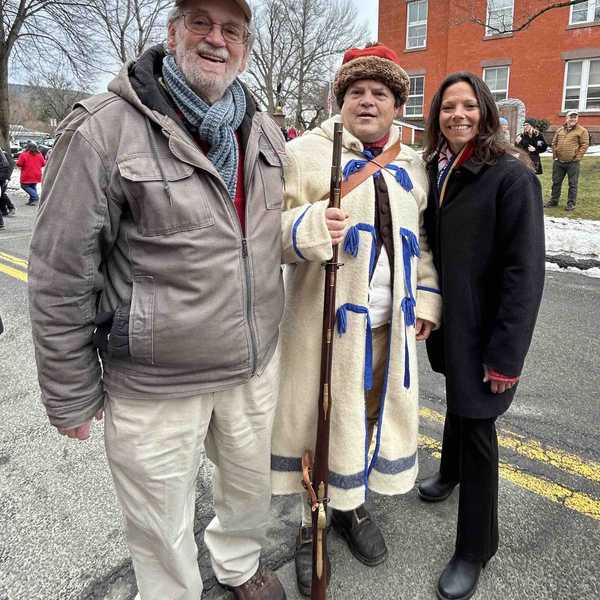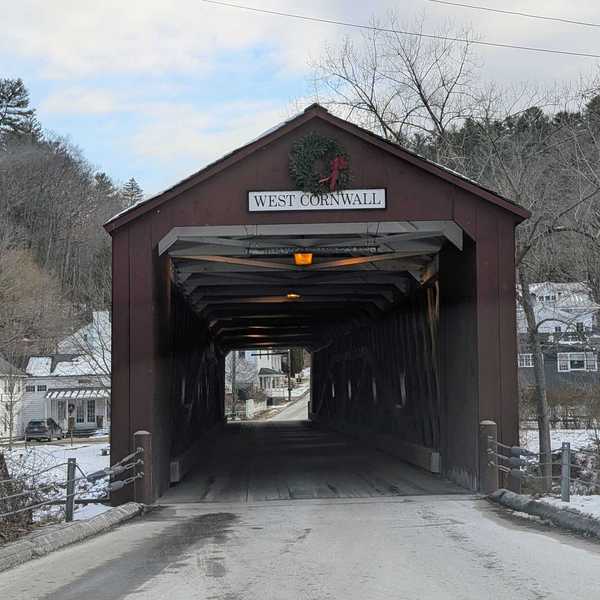Latest News
A pinch of salt
Jan 21, 2026
The Salisbury Conservation Commission enjoyed reading the Lakeville Journal’s December 22 article, “Northwest Corner Municipalities Weigh Salt Usage as Winter Returns” and is grateful for his thoughtful research.
It so happens that the Conservation Commission was working on a similar article — that it hoped to get out before the summer — entitled “A Pinch of Salt.”Here are more thoughts on the road salt situation, especially as it pertains to Salisbury.
It is winter, and who knows what might fall from the skies onto our roads and make them unsafe for travel.Fortunately, Salisbury has nine cracker-jack members of the Highway Department, akaThe Road Crew, and after our discussion with Crew Chief, Russell Hoage on November 10th, and then with Hoage and Thomas Brazee, Road Chief, in December, we feel confident telling you that Salisbury’s roads will be safe for school buses, emergency vehicles, town trucks and private vehicles this winter while environmental issues are forefront on minds and being addressed.
The Salisbury Highway Department monitors three different weather apps 24/7 to determine when and where they need to tend to ice build-up on our 60 plus miles of town roads to make winter travel safe. They are on call around the clock.The microcosms at higher elevations, such as the top of Belgo Road, typically need earlier attention than the lower roads. Before the salt/sand mixture is applied to the roads, the crew uses articulating plows to scrape off as much snow and ice, creating conditions needing less melt. (Bear in mind that the State maintains Routes 41, 44, 112 and parts of 7 with pure salt for a no-snow mandate.)
Salisbury’s roads are maintained using Salisbury’s signature gorgeous orange trucks.A recently purchased truck cost about $300,000.The Salisbury Highway Department is building the body for this truck, saving the town a lot of money, which will be stainless to prevent corrosion.
Hoage orders about 800 tons of sodium chloride a year from Apalachee Salt in Rochester, NY for about $102,000.The salt is carefully stored in a shed that has a separate bay for sand.A mixture of 2 buckets of sand to one bucket of salt is used.Hoage feels this is the best balance of melt to traction to keep roads safe, costs down and have as little sodium chloride run off as possible.
While we certainly want safe roads in the winter, we also want to protect our water sources for safe drinking water and aquatic life.
The condition of having too much salt, or fertilizer, sewage, industrial waste, or silt build up in water, which then causes algal blooms and depletes oxygen, is called eutrophication.Eutrophication is harmful to aquatic life and to the plants and organisms that filter water and make it safe to drink.
It is interesting to think that several of Salisbury’s modest rivers and streams flow to the Atlantic Ocean.If one is standing at the Scoville Library, one can see the Wachocastinook Brook and maybe hear the Salmon Kill.They are both cold-water streams known for supporting trout, that come from high elevation Riga Lake and South Pond, and both flow into the Housatonic, which is a source for Long Island Sound.When we act locally by keeping chemicals out of our water, we are also acting globally and keeping pollutants out of our oceans.
The Highway Department asks everyone to slow down! And during storms, please travel only if necessary.
Please reach us at conservationcommission@salisburyct.us for comments and suggestions.
Keep ReadingShow less
The college-age generation is grappling with inflation, increasing housing prices, climate change, and now mass corporate layoffs. In a world where geopolitical turmoil is increasing, the ground beneath their feet is shifting. Many believe their future is bleak.
My nephew, Joey, just got married. His wife lives with her parents, and he lives with his. While he makes good money as a pharmacy manager at a national chain drugstore, neither he nor his wife can afford even a down payment on a house in Long Island. They are moving in with the wife’s parents. Joey’s sister is also married with two children. They also live with their parents. Welcome to the American dream turned nightmare for almost 70 million young Americans.
The typical age range of Gen Z is 1997 to 2012. They are the demographic cohort succeeding Millennials and preceding Generation Alpha. They are the most racially and ethnically diverse generation in America, with 48% being non-white.
Almost all of this generation is highly active on social media. Almost 60% are planning to pursue a college education. They are just as likely to identify as Republicans, Democrats, or Independents. As such, the present populist upheaval the U.S. is undergoing takes an inordinate toll on them. It may be why 91% of Gen Zers report experiencing symptoms of stress and anxiety.
While Wall Street opened the year celebrating the promise of a bright future, thanks to AI. Opinion leaders predict that artificial intelligence, robots, and space, among other technological breakthroughs, will dramatically reshape the way the world works. For college grads, all they see is a no-fire, no-hire labor market where unemployment among workers ages 20 to 24 continues to rise. It is now to 5.3% and even worse for those younger than that.
The National Association of Colleges and Employers predict the entry-level hiring crisis will worsen this year, rating job prospects as poor or at best fair. At a recent gathering of employers at the Yale School of Management, 66% admitted they planned to cut jobs or freeze hiring.
With an economy that is expected to grow by 3% in 2026, one would have expected the opposite reaction, but then you would not be reckoning with the impact of artificial intelligence on the job market. Potential employers are concerned and uncertain about how AI might reshape the workforce over the next few years, and rightfully so.
Most analysts believe that many white-collar positions, especially at the entry level, will be replaced by technological advancement. Underscoring that concern, many corporate giants, including Amazon, UPS, Target, and Google, announced layoffs affecting more than 60,000 jobs. And to many, that is just the tip of the iceberg.
Faced with taking fast-food jobs at minimum wage and lacking work experience in their hoped-for professions, 3 in 5 Gen Z workers are looking elsewhere for a job with some kind of reasonable future. Almost half of these young workers believe the blue-collar jobs may offer better long-term security than corporate work in the technology fields. The top sectors pursued by Gen Z include plumbing, automotive repair, construction, and electrical work.
I happen to agree with that belief, but unfortunately, Gen Z applicants face the same barrier to entry in their white-collar arena—lack of experience. Many job applicants, regardless of industry, are now required to have at least 3 years of experience and up to 5 years before being considered.
The lure of six-figure salaries in the blue-collar area is attracting more Gen Zs to vocational schools. However, what many conveniently forget is that earning that kind of take-home pay requires years of experience, a substantial investment in personal tools and equipment, and serious wear and tear on the body.
As I write this, in the next room, a 65-year-old builder I’ll call Scott, who is going in for his second knee replacement next month, is building another room in our condo. Assisting him is a young GenZer. There is a constant stream of chatter as Scott talks through his drywalling process. His helper listens intently. They seem eager to learn and ask questions as they work. He did the same when he placed the struts and erected the wall.
For several years, Scott has been involved in a local high school program that teaches vocational school grads his business, while they gain on-the-job experience and a paycheck. Scott and others like him are providing a solution one day at a time. He is one answer to the dilemma facing this struggling generation. This country needs more Scotts to hire and teach a young workforce in need.
Next week, I will highlight one area where many Gen Xers have found an alternative to home ownership. It holds risks but doesn’t cost an arm and a leg to get involved.
Bill Schmick is a founding partner of Onota Partners, Inc., in the Berkshires.Bill’s forecasts and opinions are purely his own and do not necessarily represent the views of Onota Partners, Inc. (OPI).
Keep ReadingShow less
125 years ago — January 1901
There seems to be more small pox than in years past. Small pox is a pretty scary disease, but it doesn’t kill half as many as grippe and consumption.
They say Tesla has received a message from Mars. This sort of beats Col. Stone’s Winsted tales in the New York papers.
CHAPINVILLE — The C.N.E.R.R. Co. has commenced filling their creamery ice house, from the Twin Lakes. Thomas O’Hara has the contract of sawing the ice which is about nine inches thick.
It is said there is a big scheme on foot to take the water from the Housatonic and Ten Mile rivers for New York City. The streams would be dammed and many miles of valuable farm land would be submerged and the Housatonic rendered useless for manufacturing purposes.
Adv.: For sale at a great bargain the following articles in excellent condition, but useless to owner because of alterations in house: — 2 pairs fine lace curtains, 1 brass bedstead (double), 1 parlor sofa (mahogany and silk). For further information apply at this office.
After the ice storm of last Friday, the view which ever way one might look was one of beauty. Every twig had been provided with the ice king’s diamonds and when the sunlight fell upon them they sparkled and shone in a dazzling fashion.
100 years ago — January 1926
The women are always ready to insist upon having their rights and generally get some that belong to the masculine element. About the only thing strictly masculine that is left to the male is his mustache.
FOR SALE — Seasoned chestnut wood sawed in stove lengths. $4.50 per 2 horse double box load. Edward O’Neil, Lakeville.
Editor Krouse of the Connecticut Western News has announced that he will resign his position at least for a time, owing to the fact that his health is not all that it should be. His many friends hope that he will soon be himself again at the helm of the News.
50 years ago — January 1976
Canaan Products Inc., makers of Wash ‘n Dry, have announced they will close out manufacturing operations in Canaan by the end of March. Approximately 40 employees will lose their jobs, according to plant manager James E. Shepherd.
The concept of cable television for northwest Connecticut is still alive but is a “close question as to investment,” according to Haystack Cablevision spokesman Nicholas Eddy. Mr. Eddy, one of three partners working to bring cable television to the area, said no progress has been made.
The Lakeville Journal was awarded third place for General Excellence among all weekly newspapers in New England of 5000-6999 circulation at the New England Press Association meeting in Boston last Friday. The Journal also took second place for the Best Editorial Page in its circulation group, Class III. Those two awards brought to 14 the number of citations for excellence achieved by The Lakeville Journal in the last five years.
Fingerprints lifted from the cottage where Barbara Gibbons was killed in 1973 have been matched to those of Timothy Parmalee of Falls Village, Peter Reilly’s attorney T.F. Gilroy Daly said Tuesday. Timothy Parmalee is the brother of Michael Parmalee, who has been identified through affidavits as a suspect no longer having an alibi for the night of the slaying.
25 years ago — January 2001
Nearly 60 years ago a Canaan limestone plant became a defense contractor. It was no secret the magnesium produced was shipped for use in military aircraft and incendiary bombs. It was 1943 in the midst of World War II, but it was not until the atomic bomb was dropped on Hiroshima that it became common knowledge the majority of the mineral mined from Canaan Mountain was used in the Manhattan Project.
It came as no surprise that a report titled “The Health of Connecticut’s Hospitals” ranked Sharon as one of four “significantly distressed” in the state. The 285-page document is the result of a special act of the General Assembly in 1999 which called for the state’s Office of Health Care Access to study Connecticut’s hospital system and the factors that influence the financial conditions of hospitals.
KENT — The town hall meeting room was nearly filled to capacity Sunday as residents came to honor their “hometown hero,” former State Sen. M. Adela Eads. Mrs. Eads retired from the 30th District this month, after serving 20 years in the upper chamber. And while her area covered 15 towns, she always had a special place in her heart for the people of Kent.
Lake Wononscopomuc is home to two species of snail and two weeks that are of special concern to environmentalists, but it does not shelter any endangered species, according to a report from the state Department of Environmental Protection.
CANAAN — Librarian Norma DeMay came across some treasures. Two portraits — one an oil painting of a dignified, middle-aged man, the other an elegantly framed charcoal drawing of an older gentleman — await identification. Both pictures appear familiar, almost presidential. But a look through the book of presidents only provided the clue that the style of dress places both portraits in the mid-1800s. “It would be rather embarrassing if they turned out to be famous and we didn’t recognize them,” Ms. DeMay said. But both she and town historian Fred Hall believe the oil painting, at least, is of a local man.
These items were taken from The Lakeville Journal archives at Salisbury’s Scoville Memorial Library, keeping the original wording intact as possible.
Keep ReadingShow less
loading







